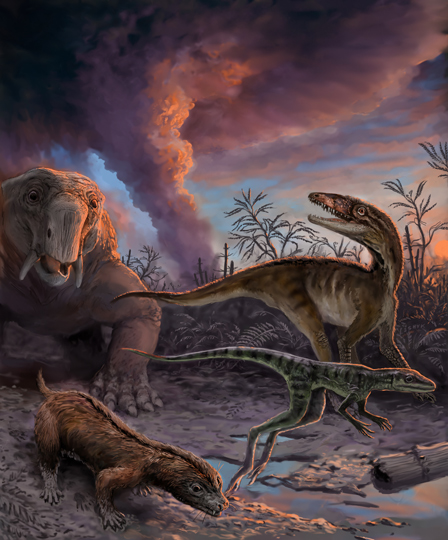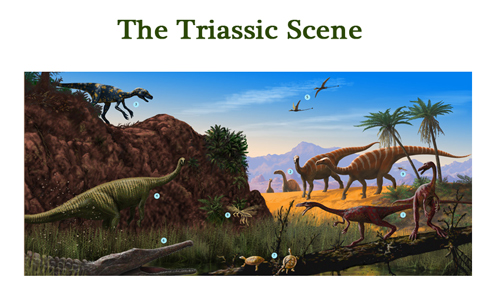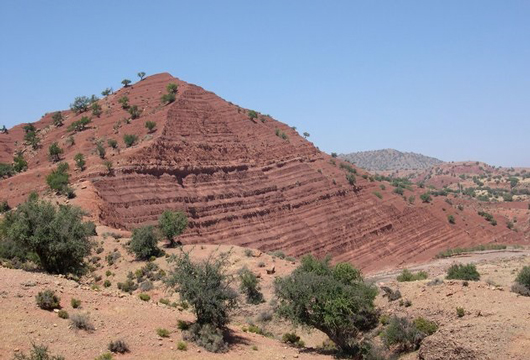Volcanic Eruptions Heralded Dawn of the Dinosaurs
End-Triassic Mass Extinction Triggered by Volcanic Activity
The demise of the dinosaurs some sixty-six million years ago has been well documented. This mass extinction event and its impact on the Dinosauria has been seared into the public’s consciousness with all the intensity of an asteroid impact, however, the domination of terrestrial ecosystems by dinosaurs may have been assisted by a period of intense, global volcanic activity some two hundred million years ago, an episode in deep geological time referred to as the end-Triassic mass extinction event.
Much of the Diverse Terrestrial Fauna of the Late Triassic Died Out
Picture credit: Victor Leshyk
End-Triassic Mass Extinction
A team of researchers based at British universities have found that huge pulses of volcanic activity are likely to have played a major role in triggering the end-Triassic mass extinction event. The early dinosaurs survived and with a lot of the competition removed, the scene was set for the domination of life on land by this Order of reptiles.
Scientists from the University of Exeter in collaboration with colleagues from Southampton University and the Department of Earth Science at the University of Oxford have published a paper that looks at the world-wide impact of immense gas emissions as a result of volcanism and their link to the end-Triassic extinction event.
Life on Earth at the End of the Triassic
Some fifty million years or so, after the “Great Dying” – the end-Permian extinction event that saw the demise of some 95% of all life on our planet, the end-Triassic extinction event led to wholesale changes in global ecosystems. Numerous food webs on land and in the sea collapsed and many different types of animals and plants were affected.
The Landscape of the Triassic
Major Casualties of the end-Triassic Extinction Event
- Marine molluscs (especially gastropods and cephalopods)
- Brachiopods
- Bivalves
- Marine sponges
- Conodonts
- Marine vertebrates – fish and many types of marine reptiles (a number of ichthyosaur genera along with the extinction of the placodonts and the Nothosauroidea)
- Several families of archosaurs along with mammal-like reptiles and numerous types of amphibians
- Large numbers of plants especially within the Lycopodiopsida (club mosses) and the Sphenopsida (horse tails)
Everything Dinosaur stocks a wide range of prehistoric animal replicas of animals that lived during the Triassic, including marine reptiles and replicas of terrestrial animals including dicynodonts and early archosaurs.
To view the range of scale models in stock: CollectA Deluxe Prehistoric Life/World Figures.
Writing in the academic journal “The Proceedings of the National Academy of Sciences of the United States of America”, the researchers conclude that huge volumes of volcanic gas had a dramatic effect on life on Earth and slowed the recovery of ecosystems afterwards.
A Large and Abrupt Release of Carbon Dioxide
Following the discovery of volcanic rocks of approximately the same age as the extinction event, huge amounts of volcanic carbon dioxide (CO2) emitted into the atmosphere had previously been suggested as an important contributor to this mass extinction event. Previous studies had also shown that this intense volcanism might have occurred in phases, over tens of thousands of years, but the global extent and potential impact of these volcanic episodes had remained unknown. Extensive areas of flood basalt, a consequence of the volcanic activity, built up across much of the super-continent of Pangaea, these basalts are now found on four continents, a consequence of plate tectonics and the break-up of Pangaea. These deposits are known as the Central Atlantic Magmatic Province (CAMP).
By studying the level of mercury found within sedimentary rocks formed during the extinction phase, the scientists were able to reveal clear links in the timing of the CAMP formation and the end-Triassic extinction. The intense volcanic activity released mercury into the environment, which spread across the planet, before being locked away in sediments. Any rocks formed during extensive volcanism would therefore have a higher than normal mercury content.
Studying Sedimentary Deposits
The research team studied sedimentary deposits from six locations (Austria, Argentina, Canada, Greenland, Morocco and the UK). The levels of mercury were analysed and five of the six records showed a sizeable increase in the mercury content at the beginning of the end-Triassic extinction horizon. Other peaks were observed between the start of the extinction event and the Triassic-Jurassic boundary, which occurred around 200,000 years later.
The Researchers Studied Sedimentary Deposits from Morocco
Picture credit: Jessica Whiteside
End-Triassic Mass Extinction Study
The higher levels of mercury coincided with previously established increases in atmospheric CO2 levels. The volcanism would have produced vast amounts of carbon dioxide that would have affected the gaseous content of the atmosphere and led to periods of global warming.
One of the authors of the scientific paper, geologist Professor Stephen Hesselbo (Camborne School of Mines at Exeter University) commented:
“This volcanic activity is strongly believed to have led to one of the largest extinction events in the Earth’s history which, in turn, paved the way for the era of the dinosaurs. By studying the sediment deposits in Europe, South America, North America and Africa, we have been able to show a large increase in levels of mercury, which shows a clear link between this volcanic activity – specifically from very large lava flows – and the mass extinction in the era. It’s a fascinating discovery that paves the way to enhance our understanding of this and other significant climate change events.”
In a press release, lead author Lawrence Percival, a geochemistry graduate student at Oxford University stated:
“These results strongly support repeated episodes of volcanic activity at the end of the Triassic, with the onset of volcanism during the end-Triassic extinction. This research greatly strengthens the link between the Triassic mass extinction and volcanic emissions of CO2. This, further evidence of episodic emissions of volcanic CO2 as the likely driver of the extinction, enhances our understanding of this event, and potentially of other climate change episodes in Earth’s history.”
To read a related article on the rise of the Dinosauria: Extreme Equatorial Climates Slowed the Rise of the Dinosaurs.




